
Introduction to the Evolution of Culinary Spaces
The idea of a kitchen — the heart of the home where meals are crafted and shared — has seen a remarkable transformation over the years. Gone are the days when kitchens were solely utilitarian rooms, hidden away from guests and devoted purely to the function of cooking. Today, culinary spaces are not only about food preparation but also about socializing, dining, and even working. As we explore how culinary spaces are being redefined, we delve into the influences driving these changes and the impact they are having on our daily lives.
The Rise of the Open-Concept Kitchen
One of the most significant shifts in kitchen design is the rise of the open-concept layout. Breaking down walls has led to a seamless flow between the kitchen and living areas, fostering a more inclusive environment. This design encourages interaction and engagement, transforming the way families and friends gather and making the act of cooking a shared experience.
Integration of Technology and Sustainability
The infusion of cutting-edge technology into culinary spaces has brought about smarter, more efficient kitchens. From energy-saving appliances to AI-driven smart systems that can assist with meal planning and inventory management, technology is playing a pivotal role in redefining these spaces. Coupled with a growing focus on sustainability, kitchens are now being designed with eco-friendly materials and appliances that reduce waste and conserve energy, reflecting the evolving values of homeowners.
Multipurpose Functionality
Modern culinary spaces are no longer just for cooking. They serve multiple purposes: a place to eat, entertain, work, and relax. Furniture and fixtures in these spaces are now being designed with versatility in mind, such as kitchen islands that double as dining tables or home office desks. The functionality of the kitchen has truly expanded, catering to the diverse activities that daily life entails.
Personalization and Style
With the increasing personalization of culinary spaces, homeowners are now more than ever expressing their personalities and tastes through kitchen designs. Custom cabinetry, unique backsplashes, and statement lighting allow for a personal touch that makes each kitchen distinctive. As these spaces become extensions of one's personal style, they contribute to the overall aesthetic appeal of the home.
Culinary Spaces as the New Social Hubs
Culinary spaces have emerged as the new social hubs, hosting everything from family gatherings to elaborate dinner parties. This has led to the incorporation of features such as wine fridges, built-in coffee stations, and specialty ovens to cater to the entertainer's needs. The modern kitchen is versatile and equipped to host events, reinforcing its status as the central space for social interaction in the home.
Conclusion: The Future of Culinary Spaces
The way we think about and utilize culinary spaces is continually evolving, reflecting broader lifestyle trends and societal shifts. As these spaces become more connected, personalized, and multifunctional, they redefine what it means to gather, dine, and celebrate the art of cooking. The future of culinary spaces promises ongoing innovation, with design and technology working hand-in-hand to create environments that are both beautiful and highly functional, ensuring that the heart of the home beats stronger than ever.